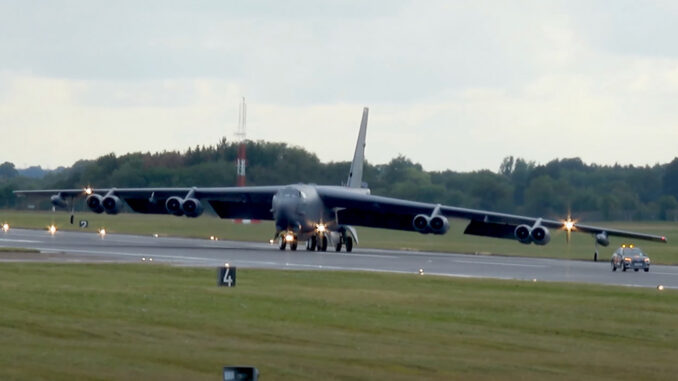A B-52H crew recently knocked out the landing lights with the port-side wing outrigger wheel while performing a crab walk demonstration on RAF Fairford’s runway.
A Doomed Counter-Ops? Ukraine Faces Its Last Battle In The Dwindling ‘Offensive’ As Russia Grinds It Down
The B-52H Stratofortress, often referred to as the Stratofortress or the BUFF (big ugly fat fellow), is a long-range, heavy bomber known for its capability to fly at high subsonic speeds and reach altitudes of up to 50,000 feet (15,166.6 meters).
The aircraft in question, airframe 61-0029/BD, is part of the 307th Bomb Wing/93rd Bomb Squadron, an Air Reserve Component of the United States Air Force, stationed at Barksdale Air Force Base, Louisiana.
On July 16, 2023, this particular B-52H, flying under the call sign SURGE 22, took part in the flying display at Royal International Air Tattoo. During the display, the B-52H executed a flypast, accompanied by a KC-135R tanker (QID 71).
However, the post-landing taxi of the B-52 took an unexpected twist as its wheel-tip landing gear appeared to collide with runway lights, with video footage from spectators quickly circulating on social media, revealing the incident at Fairford.
The public affairs office for the 307th Bomb Wing, to which the B-52 belongs, has refused to divulge additional information, citing the ongoing investigation.
A spokesperson informed Air & Space Forces Magazine that the incident is currently being investigated, and they refrain from speculating on the matter during the ongoing inquiry.
The video, shared by Epicaviation47, provides a detailed view of the B-52’s entire display, including the taxi part. In the footage, the outrigger wheel, designed to prevent the wing tanks from skidding on the runway, can be observed inadvertently causing the lights to be knocked out.
As per Epicaviation47’s account, the port-side wing of the B-52 is reported to have taken out the 18 lights during the incident.
The B-52 is equipped with a crosswind landing gear system, which proves beneficial for the crew during challenging windy conditions, as demonstrated in the remarkable footage shared in this post.
B-52H’s Wingtip Landing Gear
The B-52H Stratofortress caught the attention of many social media commenters due to its intriguing sideways movement along the runway. This technique, known as ‘crabbing,’ allows B-52 crews to navigate through narrow taxiways easily.
The unique maneuver showcases the aircraft’s impressive capabilities in handling challenging situations on the ground. The B-52 stands out from many other planes because of its wingtip landing gear situated near the ends of its 185-foot wingspan.
These specialized wheels prevent the wings, which can flex down by 10 or 12 feet depending on fuel levels, from dragging on the ground.
This feature proves particularly advantageous during taxiing and takeoff maneuvers. However, it can present challenges when the runway is too narrow for both wingtip wheels to touch down safely.
Dave Prakash, a former B-52 pilot, highlighted the difference between the B-52 and other aircraft, stating, “Other aircraft can have their wings hang out over the grass with no problem. But we have tip gear that needs a runway to touch down on.”

To address the challenges posed by the wingtip landing gear and enable the B-52 to handle crosswinds and maneuver on narrow runways, the aircraft’s landing gear was ingeniously designed to rotate up to 20 degrees to the right or left.
This swivel capability allows the large jet to execute crosswind landings with greater stability. Moreover, the swivel wheels aid in lateral movement, enabling the B-52 to taxi sideways down a narrow runway if needed.
In situations where a runway is too narrow for both wingtip wheels to touch down safely, B-52 crews can transfer fuel from one wing to another. By doing so, they ensure that the wing with the gear on the ground is appropriately loaded while the wing with the gear off the ground remains unloaded.
This clever technique optimizes the aircraft’s balance and enhances its overall maneuverability.
In the video, it seems that despite the crew’s efforts to adjust and utilize the swivel landing gear, the loaded wing’s landing gear still made contact with some of the lights on the runway.
Pilots are typically aware of the runway dimensions in advance to plan their maneuvers accordingly. Furthermore, it is a common practice to prevent potential collisions with runway lights by having a crew member disembark and guide the B-52 aircraft down the runway, ensuring a safe and clear path during taxing.
- Contact the author at ashishmichel(at)gmail.com
- Follow EurAsian Times on Google News




